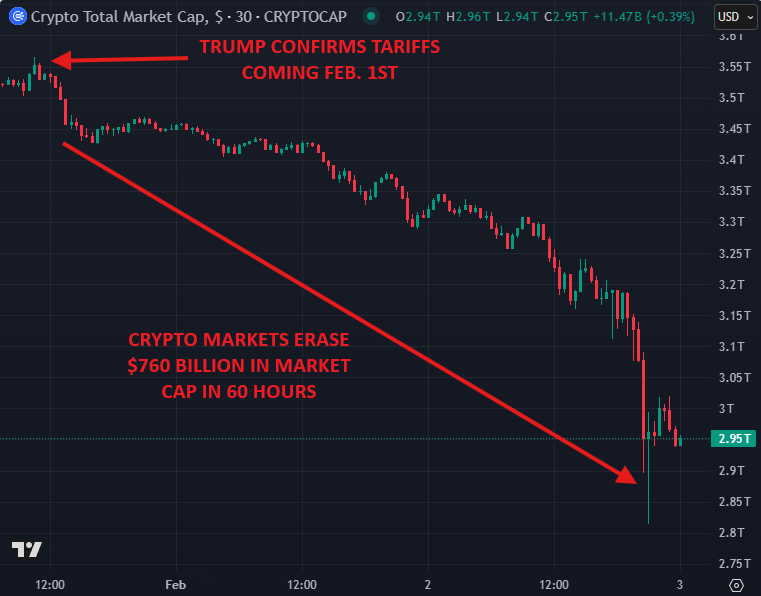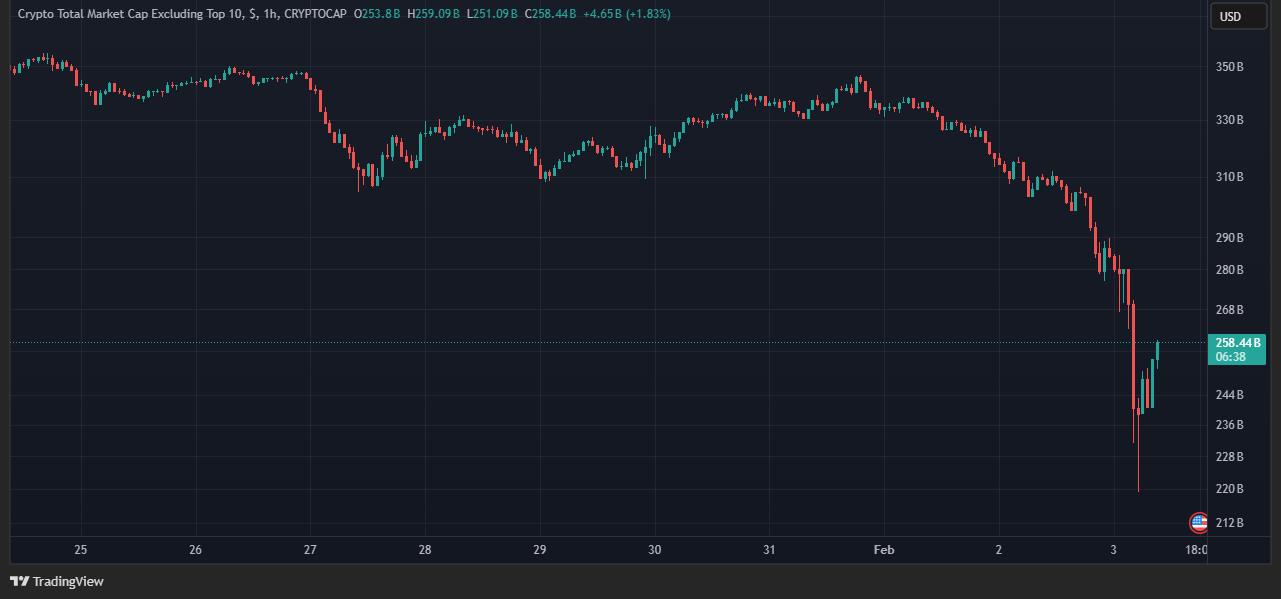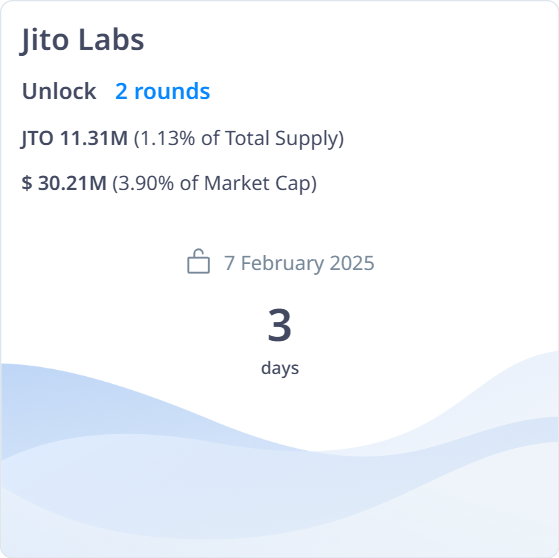
The Crypto Crash: What Happened?
This past weekend was one of the worst in crypto history. Over 2.15 billion USDT was liquidated in just 24 hours, marking the largest single-day liquidation event ever. This even surpassed the collapse of major incidents like FTX and LUNA. The crypto market lost an astonishing 760 billion USDT within 60 hours in this crypto crash, sending shockwaves through investors and traders alike.


Source | Tradingview
The main driver behind this crash was a sudden escalation in trade tensions. U.S. President Donald Trump imposed a 25% tariff on imports from Mexico and Canada, reigniting fears of a trade war. As a result, the Canadian dollar (CAD) dropped to its lowest level in 22 years against the U.S. dollar. Canada retaliated by imposing its own 25% tariffs on $155 billion worth of American goods.
The impact was immediate. U.S. stock futures plummeted at market open, with the Nasdaq falling 2.5% and the S&P 500 dropping 1.8%. The fear and uncertainty in traditional markets quickly spilled over into crypto. Bitcoin (BTC) dominance surged above 62%, meaning altcoins were hit the hardest. Ethereum (ETH) fell to 2,100 USDT, while BTC dropped to 91,000 USDT. Interestingly, Bitcoin’s transaction fees hit their lowest level since 2015, reflecting reduced on-chain activity during the panic.


Source | Tradingview
Despite the turmoil, Trump defended the tariffs, stating that “It will be worth the price” and “They cause success.” However, investors were not convinced, and the market continued to see steep losses.
Altcoin Market Wipeout
The altcoin sector saw one of its worst days ever. The OTHERS index, which tracks cryptocurrencies outside the top 10, plunged 11% and at its lowest point, had wicked down 20%. This meant that many smaller altcoins saw extreme price drops, wiping out billions in market cap. In fact, the market was losing around 12.7 USDT billion every hour since the trade war concerns intensified on Friday afternoon.


Source | Tradingview
What’s Next? Key U.S. Economic Reports and Fed Speakers This Week
The market will now turn its attention to key economic data and speeches from Federal Reserve officials. These events could determine whether the crash continues or if there is a chance for recovery.
Monday, Feb. 3
- ISM Manufacturing (Jan.) → Expected 50.0
- This report measures the health of the U.S. manufacturing sector. A reading above 50 signals growth, while below 50 indicates contraction. If manufacturing weakens, investors may grow more fearful about the economy, which could further impact markets.
- Atlanta Fed President Raphael Bostic speaks
- Bostic is known for his moderate stance on interest rates. His comments will be closely watched for any signs of policy changes.
Tuesday, Feb. 4
- Job Openings (Dec.) → Expected 8.1 million
- This report gives insight into labor market strength. If job openings fall sharply, it may signal economic weakness, adding to market jitters.
- Factory Orders (Dec.) → Expected -0.4%
- A decline in factory orders suggests businesses are slowing down, potentially confirming recession fears.
Wednesday, Feb. 5
- ADP Employment (Jan.) → Expected 122,000
- This private-sector jobs report is a preview of the official employment data coming later in the week. If it misses expectations, it could add more pressure to the market.
- ISM Services (Jan.) → Expected 54.1%
- Unlike manufacturing, the U.S. service sector has remained strong. A drop here would be a bad sign for overall economic health.
Thursday, Feb. 6
- Initial Jobless Claims (Feb. 1) → Expected 207,000
- This tracks how many people are filing for unemployment benefits. A rise in claims could signal trouble in the job market.
- U.S. Productivity (Q4) → Expected 2.2%
- Productivity growth is crucial for economic expansion. A lower-than-expected number could indicate slowing economic momentum.
Friday, Feb. 7
- U.S. Employment Report (Jan.) → Expected 256,000 jobs
- This is the most important report of the week. If job growth slows significantly, fears of a downturn will rise.
- U.S. Unemployment Rate (Jan.) → Expected 4.1%
- A rising unemployment rate would confirm economic weakness.
- U.S. Hourly Wages (Jan.) → Expected 0.3% MoM, 3.9% YoY
- If wage growth slows, it could reduce consumer spending, further impacting markets.
Upcoming Token Unlock: JITO (JTO)
- Amount: 11.31M JTO (1.13% of Total Supply)
- Value: 30.21M USDT (3.90% of Market Cap)
- Date: February 7, 2025


Source | Cryptorank
This unlock event could introduce selling pressure on the token, especially in the current uncertain market conditions.
Final Thoughts
The market is still digesting the impact of the weekend crash and the ongoing trade war tensions. With major economic reports and Federal Reserve speeches coming up, expect more volatility ahead. Investors should brace for potential further declines if data or policy statements fail to calm fears. Stay cautious and watch key events closely.
Non-Financial Disclosure: This article is for informational purposes only and does not constitute financial advice. Always do your own research (DYOR) before making investment decisions. You can explore more insights and updates on blog.millionero.com. When you’re ready, trade spot and perpetuals on Millionero to stay ahead in the crypto market.

